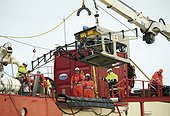Nord Stream Preparing for Munitions Clearance
- Technical and Environmental Standards Implemented in Close Cooperation with Authorities
- Baltic Sea States’ Navies Routinely Clear Mines to Enhance Safety of Maritime Infrastructure
Oct. 2, 2009 | Zug | Nord Stream is planning to start disposal of unexploded ordnance in the security corridor of its pipeline route in Finnish and Swedish waters in the fourth quarter of 2009. Safe installation and operation of the pipeline system requires clearance of 28 munitions. All related activities will be conducted as permitted by the responsible authorities and in line with environmental and safety management plans. They will be monitored according to the environmental monitoring programme. Clearance of historical naval mines and ordnance in the Baltic Sea is regularly carried out by the navies of the Baltic Sea countries in order to reduce risks they pose to shipping, fishing and ecology.
Engineering analysis based on the effects of underwater explosion has shown that a mine free “security corridor” 25 metres either side of the pipeline is required to ensure its integrity. The analysis was performed by Nord Stream’s design contractor, SES (Saipem Energy Services) and verified by the certifying body Det Norske Veritas (DNV). Within the security corridor, 27 items in Finnish and one in Swedish waters have been confirmed as unexploded ordnance. Each munitions clearance is planned separately, taking into account its specific characteristics such as size of the charge, water depth etc.
Mitigation Measures Keep Environmental Impact to a Minimum
-
Qualified Marine Mammal Observers provide technical expertise, throughout the project, also on site.
-
A Health, Safety & Environment advisor ensures that industry ‘best practices’ are followed at all times.
-
The detailed effects of the detonation are formulated by modelled information for each planned operation. This information will be used to determine acceptable safety distances for all mammals, cultural heritage and existing infrastructure.
-
Passive Acoustic Monitoring for Marine Mammals will be employed.
-
Prior to any clearance operations, a survey for fish shoals will be conducted.
-
Prior to any clearance operations, fish scaring charges and seal scrammers will be used to displace fish and marine mammals.
-
Operations will only take place during daylight in good weather conditions to ensure visual detection of mammals is effective
-
Detonation of explosives will be delayed if marine mammals are observed in the visual range of the detonation site.
Nord Stream developed its munitions clearance plan in close cooperation with the responsible authorities and supported by the Swedish, Finnish and Danish navies. It is based on an unprecedented high resolution survey of the seabed. More than 40,000 line kilometres of geophysical surveys were conducted. Over 6,000 kilometres were subjected to a gradiometer survey. Items small as a paint can could be detected by their magnetic field and over 15,000 items were inspected.
Clearance for Safety of Maritime Infrastructure
Munitions clearance is common in the Baltic Sea. Safe and proven clearance methods have been developed by the navies of the Baltic States. They routinely clear munitions – more than 800 since 1996.
In May 2009, 95 mines were cleared in Latvian territorial waters as part of the MCOPLAT 09 manoeuvre. The operation was supported by 15 ships from Latvia, Lithuania, Estonia, Belgium, Denmark, France, Poland and Germany.
From 28 Aug to 11 Sept 2009, 47 mines were cleared in Estonian waters during the operation Open Spirit 2009. 16 warships from Estonia, Latvia, Lithuania, Finland, Sweden, Denmark, Poland, France, the U.S. and Germany took part in the maneuvre.
Their methods have also been used by other national navies around the world to dispose of ordnance.
Safety for Ship Traffic
Throughout the activities, the authorities will be informed on the status. To avoid adverse impacts on shipping a safety zone will be established around each munitions clearance site during the clearance works. During the pre-detonation and post-detonation inspection surveys the safety zone will be one kilometre, during detonation one nautical mile. Before munitions clearance the locations of the activities will be announced in notice to mariners, advance warning via Navigational Telex (NAVTEX) and VHF ‘securité’ broadcasts will be issued in the affected areas.
Anchor Corridor
Nord Stream uses a DP (dynamically positioned) vessel for the installation of the pipeline from KP 8 to 300 (kilometre point – counting starts in Vyborg) and an anchored lay barge west of KP 300. Anchoring procedures are the subject of detailed risk assessments. Munitions in the anchor corridor (all places where the anchors will be placed for positioning of the lay barge) will be avoided during construction by suitable anchor patterns and control of the anchor wires’ catenary. However, where it is not possible to design an anchor pattern that ensures the safe installation of the pipeline additional clearance will be required. The results of this analysis will be available later this year.
For an illustration of the munitions clearance process please view the Nord Stream Munitions Clearance infographic.






